Leaving behind a thriving 160-acre farm in the United States, selling nearly everything, and starting a homestead in the rainforest of Ecuador while raising a nine-month-old child is not a decision many would make. But for one family, it was the path to financial freedom, self-sufficiency, and a simpler, more intentional life.
Their story is one of bold choices, resilience, and adaptation – trading a conventional farm with modern conveniences for an off-grid property in the heart of the Amazon rainforest. The journey has been anything but easy. From navigating Ecuador’s bureaucratic maze to rebuilding after devastating natural disasters, their experience highlights both the struggles and rewards of off-grid homesteading in a foreign land. Yet, despite the challenges – language barriers, agricultural setbacks, and sourcing materials locally – they have built a thriving farm, raising animals, growing organic produce, and establishing a successful trout business. Their efforts are not just about survival; they are about creating a sustainable, long-term way of life powered by the land itself.
Explore how this family made the transition, the realities of daily life on their homestead, and the hard-won lessons of living off-grid in Ecuador. If you’ve ever dreamed of stepping away from the rat race and forging a life of independence somewhere new, their story might just inspire your next big move.

From a Million-Dollar Farm to the Amazon
For 25 years, Scott and his family owned a 160-acre farm on Maryland’s Eastern Shore. It was a thriving business – a native plant nursery selling millions of plants, alongside producing alfalfa hay. The property was worth over a million dollars, and their lifestyle reflected conventional success: a beautiful home, multiple cars, and private schooling. Their family was living the American Dream, but beneath it all, Scott felt unfulfilled. “My entire life, I wanted a different lifestyle,” he explained. “I wanted to live overseas, homestead, and be as self-sufficient as possible. My mother always said, ‘I don’t want you to be 80, sitting on your porch, wishing you had done your dream.’”
For years, the idea of leaving it all behind was just a dream. But one day nine years ago, while raking hay, Scott had an epiphany. The life he had built, the one requiring $7,000 a month just to break even, wasn’t the one he truly wanted. “I came in from the tractor and told my wife my epiphany,” he recalled. “She simply said, ‘What are we doing then? Let’s do it.’ I had a green light.” With that decision, everything changed. Within a year, they had sold the farm, and most of their possessions. They packed up and moved to the Amazon rainforest of Ecuador with their nine-month-old daughter.
The transition was immediate. Gone were the structured routines of life in the U.S., replaced by the realities of starting a homestead in Ecuador from the ground up. Adapting to the culture, learning a new language, and navigating unfamiliar bureaucratic systems became daily challenges. But despite the difficulties, they embraced their new life, determined to build something sustainable, free from the financial pressures they had left behind. Their journey had begun, and there was no turning back.
The Off-Grid Setup
Scott’s family homestead in Ecuador is a true example of self-sufficiency in progress. Built in the heart of the Amazon, the property has been carefully designed to maximise natural resources for water, food, and energy. Over the years, Scott and his family have created a functional off-grid system that supports both their household and their farming operations, though the journey has been full of challenges and adaptations.
Energy: Delays in Solar Installation
Despite their commitment to off-grid living, full energy independence has proven more difficult. Scott initially planned to install solar power when they moved eight years ago, but sourcing materials in Ecuador has been both expensive and challenging. “We were quoted $12,000 for our needs and even told by installers to expect only a three- to four-year lifespan,” he said. Given the low cost and reliability of Ecuador’s hydroelectric power, it was hard to justify the investment.
“Until recently, electricity here was even more reliable than when we lived in the States,” he noted. Ecuador generates most of its electricity from hydropower, which has historically provided a stable energy source. However, as they continue working towards full off-grid independence, installing solar remains a future goal.
Water: A Reliable Rain Collection System
From the very beginning, water collection was a priority. “We have 10,000 litres of water collection for the house,” Scott explained. “We get lots of rain, and it’s very reliable. The house was designed with a sloped roof with this in mind.” Living in the rainforest means access to ample rainfall, making water independence achievable. Their system includes a carbon filter, UV filter, and ultrafiltration for drinking water, ensuring it is safe for consumption. “We had the water tested before installing filters,” he said. “It was deemed safe, but it only takes one fly-over bird to change that.”
Beyond the household supply, their streams – fed by glacial waters from a nearby national park – play a crucial role in supporting their farm, particularly their Rainbow Trout operation, which now boasts 20,000 fish. “The greenhouse and all the animals have their own rainwater collection system,” he added, highlighting the importance of ensuring every aspect of the homestead Ecuador setup remains as self-sufficient as possible.
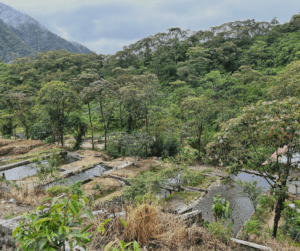
Food: Nearly Self-Sufficient Production
Scott places a high value on food production, not just for his family but also for their animals. “To me, food production – for consumption as well as animal food – is very important in off-the-grid living,” he said. “We are very close to not having to rely on stores for anything.”
Their homestead in Ecuador supports an impressive variety of crops. A greenhouse produces vegetables, while outdoor crops include multiple types of sweet potatoes, yucca, and taro. While a greenhouse may seem unnecessary considering the climate, it helps protect the plants from tropical rains and the shelter improves pollination success. They’ve also established a food forest with 200 coffee plants, 50 cacao trees, and more than 100 banana and plantain trees, alongside native fruits they propagate. Even mushrooms are part of their diverse food system.
The livestock operation is equally extensive, including pigs, sheep, chickens, ducks, quail, rabbits, and, of course, their large-scale trout farming. “We believe strongly in free-ranging our animals,” Scott explained. “This reduces costs since they forage for plants and insects, but more importantly, it creates happier, stress-free animals. This always results in better-quality products.”
While predators are not a major concern in their location, they still take measures to manage their animals effectively. Quail are kept in an aviary, rabbits live in a colony, and sheep graze within designated areas protected by solar electric fencing. Even the pigs have a pasture setup with solar-powered containment.
With their food production nearing complete self-sufficiency, their homestead Ecuador lifestyle has evolved into something far removed from their previous life in the U.S. – one that prioritises independence, sustainability, and resilience.
Daily Life on the Homestead Ecuador
Life on Scott’s Ecuador-based homestead follows a structured but ever-evolving routine, balancing animal care, food production, and ongoing development projects.
Animal care is the first priority every morning. “Every day starts the same – taking care of the animals and greenhouse,” Scott explained. The chickens, sheep, pigs, quail, rabbits, and dogs, all need food and health checks. Ensuring their welfare is not only essential for ethical animal husbandry but also for maintaining food production and sustainability.
Their trout ponds also require daily attention. Regular checks help prevent disease, ensure optimal water conditions, and maintain a steady supply of fish for both their own consumption and for sale. After inspections, they dedicate about an hour to netting fish and processing trout for market. This contributes to the homestead’s financial sustainability.
Beyond animal care, there are always other tasks to keep the family busy. “We always have projects going on,” Scott said, “from spending time tending our five acres of cardamom plants to adding more infrastructure”. Through careful planning and daily commitment, Scott and his family are constantly improving their homestead and solidifying their off-grid life in Ecuador.
The Biggest Challenges of a Homestead in Ecuador
Adapting to a new country, climate, and way of life has presented significant challenges, for Scott and his family, from bureaucratic hurdles to unexpected agricultural struggles. While they’ve learned to navigate many of these obstacles, off-grid living in a foreign country continues to require resilience and problem-solving.
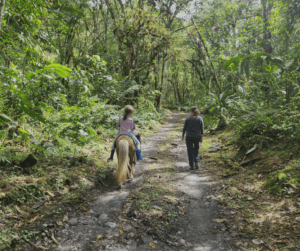
Adapting to a New Culture
Building a self-sufficient homestead in Ecuador has been a rewarding but demanding journey for Scott and his family. “Migrating to Ecuador and homesteading comes with challenges,” Scott explained, “from very slow bureaucracy and language barriers to cultural differences.” Even after eight years, dealing with government paperwork can still be time-consuming and frustrating.
Language was another obstacle, particularly in the beginning. “Of course, there is the language barrier. But after eight years, this has gotten much better,” Scott shared. Learning Spanish has helped them integrate with the community, access resources, and work more efficiently with suppliers and workers.
Unlike in the U.S., where supplies can be easily ordered online or found in big-name stores, sourcing materials in Ecuador is far more challenging. “Finding supplies is a huge challenge,” Scott admitted. “There is no Home Depot, no Amazon delivery service. It takes a lot of searching to find the simplest things.” This lack of accessibility means that every project, or repair requires careful planning. Items that would be taken for granted elsewhere – like building materials or tools – often require long trips to multiple suppliers or waiting for shipments to arrive.
Environmental Complications
Another complication has been learning new agricultural practices. Despite his extensive experience in the U.S., Scott initially struggled to adapt to Ecuador’s unique growing conditions. “I’m considered a native plant expert in the USA,” he said. “I had ten 32×96-foot greenhouses propagating native plants and installed millions.” But Ecuador presented a whole new set of challenges.
With no defined seasons, consistent temperatures year-round, and heavy rainfall, many familiar crops did not behave as expected. “I struggled to grow tomato plants,” he said. The constant 12-hour daylight cycle, unfamiliar pests, and excessive moisture created unexpected difficulties. Fortunately, with the help of local farmers, they were able to adjust their approach and now successfully grow vegetables, fruits, and spices.
Living in a remote region of Ecuador also means dealing with unpredictable weather at their homestead. Heavy rainfall is a constant factor, sometimes leading to devastating consequences. One particularly severe rainstorm had a catastrophic impact on their homestead. “It completely wiped out our trout ponds,” Scott recalled. Events like this require not just rebuilding but also rethinking how to make systems more resilient in the future.
Despite these challenges, Scott and his family have continued to adapt, finding ways to overcome obstacles and improve their homestead. Their experience highlights the realities of off-grid living in Ecuador – demanding but ultimately rewarding for those willing to embrace the learning curve.
Community and Resilience on a Homestead in Ecuador
While homesteading in Ecuador has brought its share of challenges, Scott and his family have also discovered an unexpected strength – an incredibly supportive local community. From daily life to disaster recovery, the people around them have played a crucial role in helping them adapt and thrive.
Locals Living Off-Grid
The local community has been instrumental in helping Scott and his family navigate the realities of homesteading in Ecuador. Farming in a new climate came with a steep learning curve, but their neighbours, many of whom have lived off-grid for generations, were eager to share their knowledge.
“With the help of the locals, we are now growing all our vegetables and huge amounts of fruit,” Scott said. Ecuadorian farmers often work with nature rather than against it, using traditional methods suited to the region’s unique conditions.
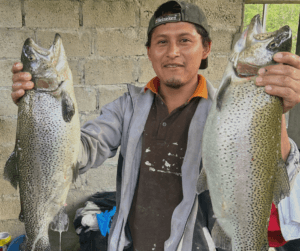
Interestingly, many of the people in their community live off-grid, though they don’t necessarily call it that. “They don’t have solar for electricity – they simply don’t have electricity,” Scott explained. “Outhouses and waterfall showers are common.” Their approach to self-sufficiency isn’t a lifestyle choice but a necessity, and their deep-rooted knowledge has been invaluable in helping Scott’s family build a sustainable homestead.
A Strong Local Support Network
Scott and his family experienced first-hand how tight-knit and generous their community could be when disaster struck. During a particularly intense rainstorm, Scott was away in the U.S., leaving his wife and daughter alone on the property. Heavy rains – seven inches in just two hours – caused their land to flood catastrophically.
“Our lagoon, which I had built as a safety feature for our trout, completely filled with material,” Scott recalled. Without water flow, all their trout died, and debris piled ten feet deep over their driveway, trapping his wife and daughter. Worse still, the public road leading away from their property was completely washed out, leaving them stranded.
Yet, by morning, help had already arrived. “By 6:30 a.m., the neighbours were at our house, asking what they could do to help. By 10 a.m., the driveway was cleared – by hand – so my wife could get out,” Scott shared. The sense of solidarity didn’t end there. Two months later, the municipality arrived, not only repairing the public road but also restoring their lagoon. “I didn’t understand. It’s private property?” Scott asked. “They said, ‘You are part of this community. We are here to help.’” This level of community support is something many people wouldn’t expect, but in rural Ecuador, it’s a way of life.
By leaning on the experience and generosity of their neighbours, Scott and his family have not only found a way to survive homestead-life in Ecuador but to truly thrive.
Financial Sustainability on a Homestead in Ecuador
Generating an income is an important part of off-grid living. Scott admitted that doing so in Ecuador wasn’t easy in the beginning. “We have struggled to make a living here. We’ve had many ideas, but finally they’re coming to fruition,” he said. “Unlike in the U.S., where remote work or e-commerce can provide steady income, earning a livelihood in rural Ecuador required hands-on, locally adapted solutions.”
After some experimenting, Scott and his family found success in several key areas. Their rainbow trout business is generating a steady income, providing fresh fish to the local market. They also sell piglets and processed lamb to other locally-based expats. Scott has even started making jerky and smoking salmon, further diversifying their income streams.
The biggest breakthrough came from their organic coffee and cacao sales. Recognising a gap in the market, Scott leveraged his Facebook page as a platform to sell their 100% organic products. “Coffee is the number one chemically treated agricultural product in the world. Ours is 100% organic,” he explained. The demand quickly exceeded expectations, with orders coming from all over, including the USA, Canada, Europe, Hong Kong, and Australia.
Despite their success, growing the business has presented additional challenges. For the past year, Scott has personally transported 200 or so bags of coffee and cacao in his suitcase to the U.S. each month, where he then ships them to customers. While this method allowed them to test the market, it’s not a long-term solution. “The biggest challenge – it’s taken off more than expected,” he admitted.
To keep up with demand, Scott is working on shipping directly from Ecuador and establishing a U.S. distributor to streamline logistics. As they refine their operations, they aim to make their homestead in Ecuador not just self-sufficient, but financially sustainable for the long term.
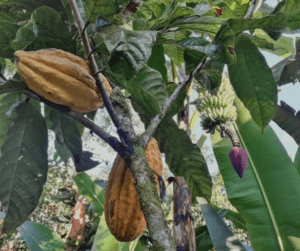
Future Plans and Recommendations
As Scott and his family continue on their homestead journey in the rainforest of Ecuador, they are focused on long-term sustainability, expanding their agricultural output, and improving infrastructure. Their journey has required adaptation, resilience, and a willingness to embrace change – something Scott encourages others to consider.
The Next Steps
A historic drought last year led to 14-hour daily blackouts, as hydroelectric stations struggled to generate power. Fortunately, Scott’s family had a propane generator, which allowed them to manage without major disruptions. However, the experience highlighted the need for a more self-reliant energy system.
“This pushed us to now install solar,” Scott explained. Solar power will provide a reliable, renewable energy source, helping them avoid dependence on the national grid. They are also implementing hydropower, which will provide electricity in areas of the property where solar power is less accessible.
In addition to electricity, they are building a biodigester for propane production. “This likely won’t satisfy our needs but will supplement them,” Scott noted. By converting organic waste into biogas, the biodigester will help offset fuel costs and reduce waste while adding another layer of energy security.
Beyond energy, Scott’s family continues to expand their agricultural operations, building on the success of their organic coffee and cacao sales. While international shipping remains a challenge, they are working towards a more streamlined distribution system to meet growing demand.
Advice for Others Considering a Homesteading Lifestyle
Scott recognises that relocating to somewhere like Ecuador and starting a homestead is not the norm. But for those considering a similar change, his recommendations are clear.
“My advice would be to think about it, do it. Make the change,” he said. “Whether that is moving to another location in your town, state, another state, another country, or another hemisphere. Life is too short.”
Once you commit, Scott recommends going all in, but get help when you need it. “Ask questions. There is no shame in asking for help – whether you need guidance on how to raise chickens, set up a rain collection system, or move to homestead overseas.”
Conclusion
Scott and his family’s journey from a thriving American farm to an off-grid homestead in Ecuador’s Amazon has been a life-changing experience. Their story highlights the challenges of homesteading in a foreign country, from navigating bureaucracy and sourcing materials to adapting to a new climate and overcoming natural disasters. Yet, despite these obstacles, they have built a sustainable lifestyle, producing their own food, running a successful trout business, and integrating into a supportive local community.
Their demonstrate that off-grid living – especially in an unfamiliar environment – is not for the faint-hearted. It requires problem-solving, patience, and a willingness to embrace the unexpected. But for those willing to take the leap, the rewards can be limitless: financial freedom, a deeper connection to the land, and a life shaped by intention rather than obligation. For Scott and his family, the decision to follow their dreams – trading conventional success for a homestead in Ecuador – has proven to be the right one.
To follow Scott and his family’s homestead adventures or enquire about his coffee and cacao produce visit their Facebook page.
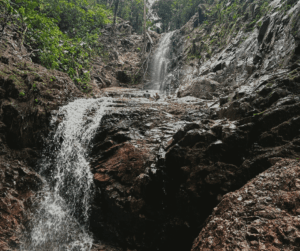
To find out more about off-grid living return to our Reading Room.


